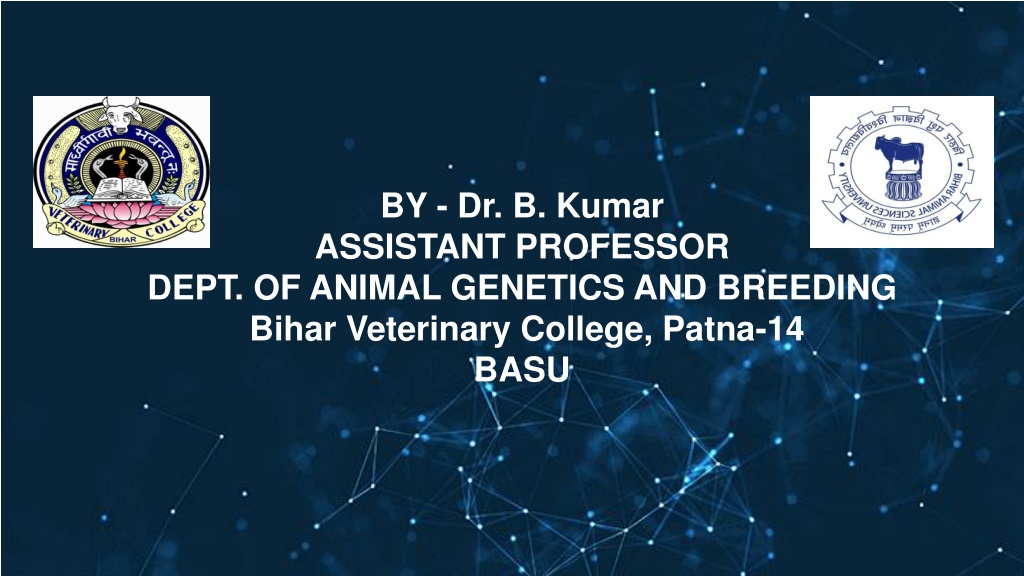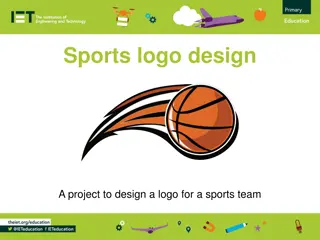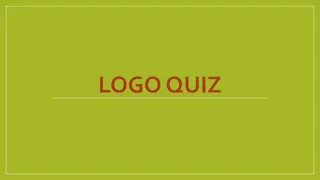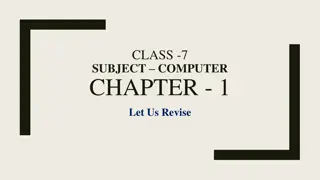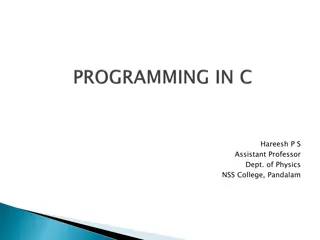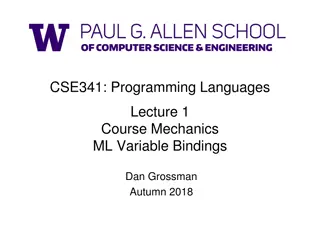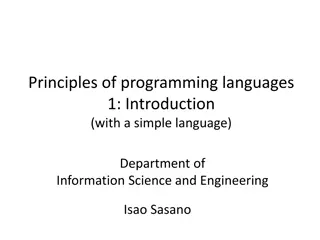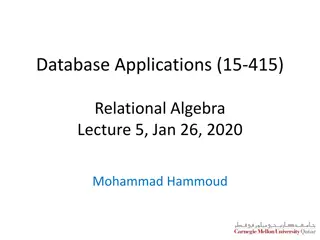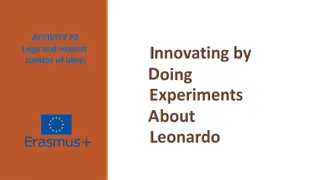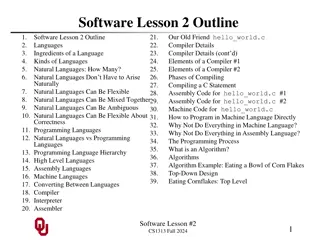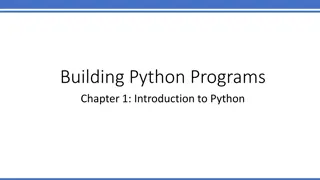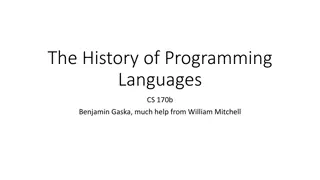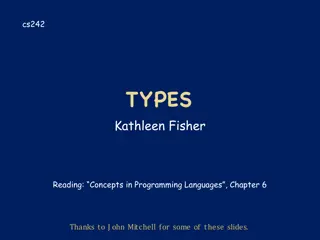Introduction to Programming Languages and LOGO
Explore the world of programming languages with a focus on BASIC, then delve into the simplicity of the LOGO language for graphic-oriented tasks. Learn about the history, usage, and uniqueness of each language along with practical applications.
Download Presentation

Please find below an Image/Link to download the presentation.
The content on the website is provided AS IS for your information and personal use only. It may not be sold, licensed, or shared on other websites without obtaining consent from the author. Download presentation by click this link. If you encounter any issues during the download, it is possible that the publisher has removed the file from their server.
E N D
Presentation Transcript
BY - Dr. B. Kumar ASSISTANT PROFESSOR DEPT. OF ANIMAL GENETICS AND BREEDING Bihar Veterinary College, Patna-14 BASU
Programming Language of Computer
Introduction of Programming Language We speak many languages like Hindi, English, Punjabi, Tamil, Marathi etc. These are the regional languages through which the people of same region communicate with each other. So a language is a medium through which you can express your ideas to others. You know that computer is a machine. It does not understand the language we speak. If we want to communicate with a computer, we must learn its language.
Introduction of Programming Language The full form of BASIC is Beginners All Purpose Symbolic Instruction Code. This language is best suited for beginners. This is a very user-friendly language, which develops interest of programming in the beginners. Generally, all types of tasks can be done using BASIC, i.e., graphics, general programs, using musical tones, drawing figures, etc. John Kemeny and Thomas Kurtz developed Basic language in the year 1960 at Dartmouth College, USA.
Introduction of Programming Language We have also seen that a computer can understand only a computer language, which is translated into its equivalent machine level language for processing. In this chapter, we will see how we can instruct the computer, using a high level language called BASIC. Different types of computers language : Some of the computer languages are LOGO, BASIC, PASCAL, FORTRAN, C++, JAVA, etc.
Computer languages - LOGO In this chapter, we will learn about LOGO language. LOGO is one of the easiest and simplest computer languages. Using LOGO, you can draw different types of figures, solve mathematical problems and can even write messages on the screen. LOGO: Language Of Graphic Oriented Or Language Oriented Graphic Oriented LOGO is available in two different forms: (i) PC LOGO- Works with MS-DOS. (ii) MSW LOGO- Works with Windows operating system.
Computer languages - LOGO In Starting with MSW LOGO To star MSW LOGO, you have to follow these steps: Step 1: Click on Start button. Step 2: Select All Programs from the Pop-up menu. Step 3: Click on Microsoft Windows LOGO. The MSW LOGO screen displays as shown below: The MSW LOGO Screen is basically divided into two sections: I. The Main Screen It shows the output of the program/commands. Turtle is used to draw figures and type text in the main screen. II. The Commander Window
Computer languages - LOGO This window is used to give commands to LOGO. It is further divided into two parts: (a) Recall List Box Command Input Box: This box is used: To type all the commands. To execute the commands by clicking on Execute button or by pressing the Enter Key. Recall List Box: To keep all the instructions typed in the Input Box. To view the command that goes out of view in the Input Box. It can be done by clicking the scroll bar. (b) Command Input Box
LOGO TURTLE When you open Microsoft Windows LOGO, MSW LOGO Screen appears (by default). You will also notice a triangle that appears in the middle of the screen. This triangle is known as LOGO TURTLE. This turtle is like a pen used to draw on the screen. The center of the screen is called the Turtle s Home . The turtle moves all over the screen only when you type the commands. Whenever the turtle moves on the screen, it leaves a trail (footstep) on the screen. The LOGO turtle has following two points: The point, which is facing the upper side of the screen, is called NOSE or HEAD. The bottom part of the Turtle is called its BACK or TAIL. The turtle always moves straight in the direction of head.
AN Exit LOGO After completing your work in LOGO, it is necessary to come out of LOGO. You can exit LOGO by typing BYE in the Input box and pressing the Enter key. Click on File option and select Exit from drop down menu. This way, you will go back to the Windows desktop. LOGO Commands Command means giving orders to the computer in its language. In case of LOGO, the turtle moves on the screen following the commands given by you. Let us learn about the different types of commands given in LOGO.
Different Types of LOGO Commands Let us learn about the different types of commands given in LOGO. Forward Command (FD) Back Command (BK) Right Command (RT) Left Command (LT)
Home Command HOME is a primitive. This command brings the turtle back to its starting position. When we give HOME command, the turtle comes back to the center of the screen with its head pointing upwards. Let us take an example: FD 60 RT 90 FD 40 HOME Clear Screen (CS) The short form of Clear Screen is CS. This command erases the drawing, which is on the screen and brings the turtle to its Home (Center of the screen). It is always to start work with a clear screen.
we learn BASIC language programming, let us define a program. Program: A program is step-by-step set of instructions, given to a computer, using a computer language, to solve a problem. Every computer language follows some particular rules for processing. We must follow these language rules if we want the computer to give meaningful results. BASIC language also follows certain rules. Some of the main points that we should take care of while writing a BASIC Program are given below: Every statement must begin with a line number. The line number must be a positive integer. Line numbers must be in ascending order. After completion of each line, you must press the Enter Key.
BASIC Commands and Statements When some instructions are given to a computer, they can either be in the form of a command or a set of commands. Command Command means order. It is a single word, which tells the computer to do a specific task. The different BASIC commands are: CLS, RUN, LIST, SAVE, DELETE, LOAD etc. For example, if you already have some text on the screen on C-prompt and you want to clear the screen, type CLS and press Enter key. It clears the screen as shown: Statement These are the set of instructions, which can only be used in a group. They are used to write programs to obtain desired output from the computer. The different statements available in BASIC are: LET, GOTO, INPUT, IF-THEN, PRINT, READ- DATA, FOR_NEXT etc.
BASIC Commands and Statements Statement These are the building blocks of a program. These are the set of instructions to a program. Each statement requires a line number. Command It is a single word to perform a specific task. It gives a specific order to a program (i.e. what to do). A command may or may not require a line number.
Different Types of Command When you want to write a program in GWBASIC, you should know the following commands/statements, which are essentially needed. These commands/statements are: NEW Command If you want to start typing a new program, use NEW command before writing the program. CLS Command CLS means clear the screen but not the contents of the memory. Sometimes, it is required to clear the screen before writing on the screen. So type CLS and press Enter key as shown: END Command END command is used to terminate a program permanently and it can be used only once. It has to be the last statement of the BASIC program
